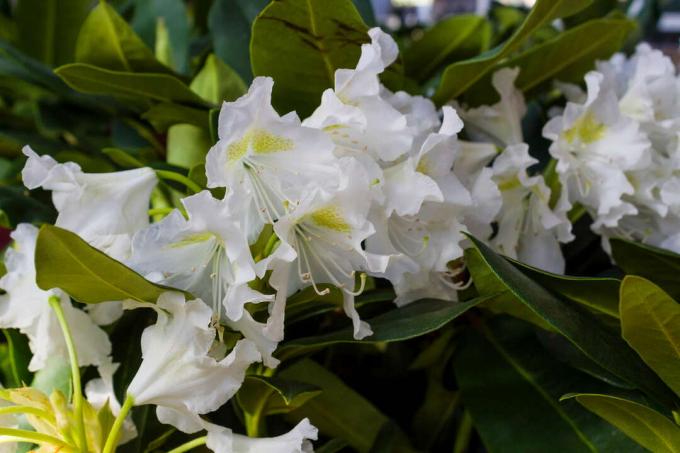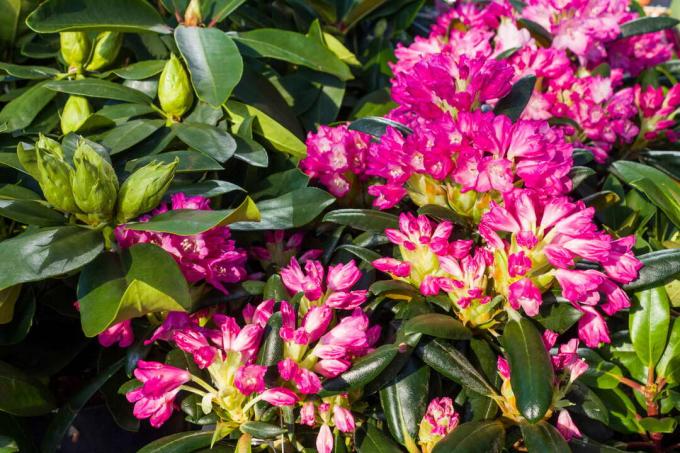Has your beloved rhododendron got too big? Time to move. Find out here how to properly transplant your rhododendron.

Rhododendrons (rhododendron) are not only replanted if they have become too big for the previous location or if they simply disturb the harmony of the newly created garden. Transplanting is usually the last hope for recovery and abundance of flowers for ailing or poorly growing rhododendrons. Because the popular ornamental shrubs place high demands on the soil in which their roots grow.
Rhododendron location: It is important to note this
Rhododendrons are picky about their location, with the soil in particular being the deciding factor for better or for worse. Make sure that the soil has a slightly acidic pH value between four and five, and that it is loose and humic. When it comes to the lighting conditions at the ideal location, a partially shaded location is usually preferred. However, attention is paid to good soil properties, and sufficient water supply and humidity are provided, so rhododendrons also thrive in full sun locations. Make sure you leave enough space between the rhododendron and other plants, as the roots spread out very flat.
Transplanting rhododendrons: when is the best time?
May is the ideal month to transplant your rhododendron. But it is also possible to move in early autumn (September to October). After a radical pruning, you should not transplant your rhododendron for the first two years. The plant needs a lot of time and energy to promote crown growth. The plants lack this energy in the roots after transplanting.

Transplanting rhododendrons: instructions
The first and also one of the most important points when transplanting one of your leafy friends is digging up the plant in its old location. Knowing about root growth is crucial. Rhododendrons form flat, extensive root systems. The excavated root area should have a large diameter, but does not need to be particularly deep. The diameter should be around three quarters of the height of the rhododendron. The bale height should be approximately half the bale diameter. Use a spade to carve a circle around the plant that way. Then this is used to lift the roots all around. Even if the main roots are damaged, a rhododendron can usually still handle transplanting very well. If you still want to be particularly careful, dig the circle a little wider in March to April and fill it loosely with earth. It is then only replanted in autumn, when new fine roots have already formed. With some effort, the rhododendron and its roots can be pulled out of the earth. At the new location, follow these steps to professionally transplant your rhododendron:
- Dig the planting hole: two to three times as large as the diameter of the root ball
- Mix in the excavated soil with compost
- Sand is mixed in with heavy soil
- Loosen the surrounding earth
- Lay out a drainage layer of potsherds or gravel on the ground
- Place the plant with the roots in the planting hole
- Fill the planting hole with soil mixture so that about 2 cm of the root ball is still visible
- Press the earth down
- Pour vigorously and pour more in the growth phase
- Fertilization with horn shavings, flour, compost (superficial incorporation)
- Spreading a layer of mulch in the root area
- Do not prune the plant after transplanting
tip: You can also use ours Plantura organic hydrangea fertilizer Put as start fertilizer in the planting hole for the rhododendron. This contains all the nutrients for a rich bloom and extra iron.

You can also completely replace the excavated garden soil with special rhododendron soil. This ensures optimal soil conditions and strong growth with a rich flowering. If the plant is to be put back into the ground in the same place, the hole created during the excavation is doubled again. The plant is set back a little higher than before in the planting hole. A soil mixture as described above or special rhododendron soil is used to fill the planting hole.
To ensure that your rhododendron continues to grow healthily, you will find all the important information about Care of rhododendrons.

